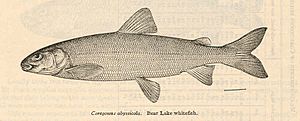Bear Lake whitefish facts for kids
Quick facts for kids Bear Lake whitefish |
|
|---|---|
 |
|
| Scientific classification |
The Bear Lake whitefish (Prosopium abyssicola) is a special type of fish that only lives in Bear Lake. This lake is located on the border between Utah and Idaho. It's a member of the salmon family, which also includes salmon and trout.
The Bear Lake whitefish is one of three types of Prosopium fish that are found only in Bear Lake. The other two are the Bonneville whitefish and the Bonneville cisco. The state of Utah considers the Bear Lake whitefish a Wildlife Species of Concern. This means they are watching it closely to make sure its population stays healthy.
Contents
What Does It Look Like?
The Bear Lake whitefish looks very similar to its close relative, the Bonneville whitefish. It is generally whitish in color.
Key Differences
The Bear Lake whitefish has a slightly rounded nose, which some people call a "Roman nose." It also has larger scales than the Bonneville whitefish.
One important difference is that the Bear Lake whitefish never has spots. Young Bonneville whitefish, up to about 10 inches long, often have a pattern of spots. The Bear Lake whitefish is also usually smaller. It rarely grows longer than 9 inches. The longest one ever found was about 11 inches.
Where Does It Live and What Does It Eat?
The Bear Lake whitefish mostly lives in the deeper parts of the lake bottom. It likes to stay in these deep areas.
Food Sources
This fish eats many kinds of small creatures that live in the water. These include tiny invertebrates like ostracods, copepods, and different types of insects.
Spawning Habits
The Bear Lake whitefish lays its eggs, a process called spawning, from late December to early February. It spawns in water that is 50 to 100 feet deep.
Is It Easy to Catch?
The Bear Lake whitefish is rarely seen close to the shore. Because of this, it is not often caught by people using a hook and line.
See also
 In Spanish: Prosopium abyssicola para niños
In Spanish: Prosopium abyssicola para niños

